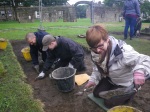You may remember a while ago that we featured a brief anecdotal story about a retired pharmacist Cissie Yeadon? Well fortunately for us, Cissie agreed to blog more of her career.
Cissie served her apprenticeship at Boots The Chemists in Kirkgate, Bradford from 1947 – 1949. She qualified in 1950 in Edinburgh as an external student of Bradford Technical College, as it did not have university status then. At this time, Cissie was becoming one of only a few women who were brave and clever enough to embark on such a career in medicine.
When the National Health service first came into being, she thought it was the ‘best thing since sliced bread’! She still maintains this opinion, and believes it to be one of our finest achievements despite all of the criticism and abuse it has suffered. Cissie believes that when she undertook her training that it really was in a different world altogether, compared to today.
Back then, most medicines were made from plant derivatives and made by hand to order. Tinctures contained ingredients preserved in alcohol, for example, Tincture of Digitalis, Belladonna, Stramonium or Nux Vomica. Latin names and labeling were used for the medicines to correspond with their Latin ingredients.
If customers came along with a specific prescription that needed to be made up, Cissie would enter their prescription specifics into a prescription book and issue them with a number. This allowed them easy access to that particular prescription again if that customer required it….genius!
Before awareness and legislation came in to protect pharmacists and patients, many a mixture would include small quantities of highly poisonous and dangerous derivatives. Back then, adult cough mixtures contained opium balanced with an emetic such as squill or ipecacuanha.
Methods of making medicine have also vastly changed, Cissie made very intricate and complex mixtures that would be used for various illnesses. ” I used to make pills, suppositories, pessaries, plasters, cough mixtures, stomach medicines and tonics”.
Let’s take a look into how pills were made…….”Pills were made by mixing the active ingredient with an inert substance and rolling it into a kind of sausage shape which was then put into a pill machine which then divided the sausage up into small cylinders. These pieces were then put into a pill rounder with French chalk to prevent them from sticking together. A pill rounder was a small cylindrical wooden box usually made form polished wood. The pills were thoroughly shaken with a round motion until they were round. They were then coated with a non toxic (and often sweet!) varnish and placed carefully on a well greased til and left to dry with regular turning to prevent them from sticking.” Cissie would have made hundreds of thousands of pills in her time as a pharmacist, for many different ailments.
Suppositories and pessaries were also hand made in the dispensary, the base of which would have been cocoa butter or glycerine. This would be carefully heated, but not left to boil or bubble. The active ingredient would then be added and the mixture poured into a mold, and left to cool. If you were using cocoa butter for the recipe, then Cissie would over fill the mold to allow for shrinkage. However, glycerine would not shrink, so they were filled exactly.
When antibiotics appeared on the scene they took the form of Penicillin lozenges, cream and ointment. Lozenges and ointments came directly from the manufacturers, but creams were made in house at the dispensary. To make the cream Cissie had to use what they used to call an aseptic technique. She needed to don sterile gloves behind a screen which had sterile curtains, and use a sterile rod to mix the penicillin tablet into the mixture.
Later Streptomycin and other antibiotics were discovered, so gradually old herbal and plant based medicines were phased out and replaced by more modern products.
Cissie finally retired when she was 77 years old after experiencing many changes in medicine throughout her career.
If there weren’t people like Cissie to make our medicines back then, who would have hey?







